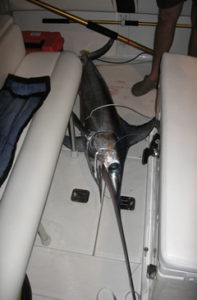
The Atlantic Swordfish is a notable species for fishing enthusiasts along the Virginia Coast. Recognized for their formidable power and graceful silhouette, these fish are often referred to as the “gladiators of the deep.” Their resurgence in popularity is due to recent recreational catches, highlighting their dynamic presence in Mid-Atlantic waters.
Swordfish possess a distinctive appearance, characterized by a robust, rounded body and an elongated, flattened bill, which is the source of their name. As nocturnal predators, they have large black eyes and a blackish-brown hue, adapting them perfectly for deep-water and nighttime hunting.
These remarkable fish are classified as a pelagic species and inhabit tropical to temperate waters globally. They are acknowledged as one of the ocean’s largest and fastest predators, capable of reaching lengths of up to 15 feet and weights exceeding 1,400 pounds, with the current all-tackle world record being 1,182 pounds. Pacific swordfish tend to grow larger than those found in other regions, while in the Atlantic Ocean, females typically reach around 700 pounds, and males rarely exceed 300 pounds. Sexual maturity occurs between three to six years of age, and swordfish can live for up to 25 years.
Swordfish, typically found at depths of 650 to 2,000 feet during the day, are occasionally observed at the surface, making them accessible targets for harpooners. These fish are known for their strong jumping abilities, often breaching into the air, possibly as a method to remove external parasites or to stun prey.
The bills of swordfish are distinctive, being truly sword-shaped, unlike those of other billfish. This appendage can be as long as one-third of the fish’s body length and is pointed, strong, and sharp, serving as an effective weapon. Handling swordfish requires caution, as improper techniques can result in dangerous injuries. There are accounts of swordfish damaging small boats with their bills during encounters.
The highly migratory swordfish are found in the Atlantic, Mediterranean, Indian, and Pacific Oceans. They migrate to colder northern waters in summer and warmer southern waters in winter for spawning. Swordfish inhabit subtropical and tropical regions year-round. Unlike other billfish, they tolerate a wide range of temperatures, enabling them to traverse various temperate waters and travel deep where temperatures approach freezing. They have an anatomical adaptation—a tissue bundle with a specialized vascular system—that insulates and warms their brain, preventing damage from rapid cooling during extreme vertical movements.
Predators
Swimming alone or in very loose aggregations, swordfish are mostly solitary hunters. These predators of the deep will feed at very deep depths, moving to the surface mostly at night in search of smaller fish such as menhaden, herring, mackerel, bluefish, hake, and butterfish. Sword in the north Atlantic, swords also prey on squid and other cephalopods.
Recreational Interest
Swordfish have been a popular sport fish since the early days of sport fishing, known for their strong fight and excellent taste. In the mid-1970s, night-time fishing with lights became an effective method for catching them.
When fishing for swordfish in Atlantic waters, follow recreational regulations to avoid penalties. The daily limit is one fish per person, up to three fish per boat, with a minimum size of 47 inches (lower jaw to fork length). You need a vessel permit from the National Marine Fisheries Service, and all catches must be reported within 24 hours to aid data collection.
Commercial Interest
The commercial swordfish industry has a long-standing history, with numerous nations participating in the harvesting of swordfish for commercial purposes. In the Atlantic Ocean, swordfish fisheries predominantly utilize long lines, although the industry originally began with harpooning. Long lines consist of a main line adorned with thousands of baited hooks, stretching up to 30 to 70 miles in length. These lines are supported within the water column by a buoy system. Unfortunately, long lines are non-selective, leading to by-catches of undersized swordfish and other marine species such as turtles and marlin.
In 1948, the global commercial swordfish harvest amounted to 7,000 tons, with steady growth observed each year. By 1970, the world harvest had increased to 37,000 tons. However, that same year, reports of high mercury levels in swordfish raised consumer concerns, prompting the FDA to implement strict regulations on their sale, which significantly reduced demand. Once the FDA raised the acceptable level of mercury in 1979 and later revised its stance on mercury level enforcement, fears of contamination diminished, resulting in swordfish harvests surpassing 80,000 tons per year. This substantial increase in harvesting exerted immense fishing pressure on worldwide swordfish populations.
Management and Conservation
Managing swordfish requires international cooperation as they cross global boundaries. The International Commission for the Conservation of Atlantic Tunas (ICCAT) oversees Atlantic swordfish management, with over 30 members including the U.S. Domestically, the National Marine Fisheries Service (NMFS) ensures compliance with ICCAT’s decisions.
In the 1980s, heavy fishing led to a significant decline in swordfish populations. ICCAT introduced a 10-year recovery plan in 1999 to rebuild north Atlantic swordfish stocks, involving catch reductions and protections for juvenile swordfish. By 2006, data indicated the fishery was nearly rebuilt with low mortality rates.
This year, NMFS is considering new measures to enhance U.S. anglers’ opportunities to harvest swordfish quotas sustainably. The Atlantic swordfish exemplifies successful global conservation efforts.









 Views Last 7 days : 1935
Views Last 7 days : 1935 Views Last 30 days : 6777
Views Last 30 days : 6777